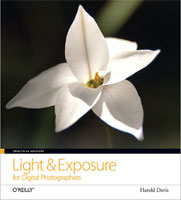
Light & Exposure for Digital Photographers,
by Harold Davis
http://digitalmedia.oreilly.com
ISBN: 978-0-596-52988-8, 176 pages
$29.99 US, $29.99 CN
More and more people these days have digital cameras. What is traditionally called point-and-shoot cameras are extremely popular, and affordable and for the most part they produce really good photos. But if you’re serious about photography, at some point you’ll have to get beyond the automatic exposure settings of your camera and learn about the marriage between light and exposure and how to use the features of your camera to make that marriage work.
For the last few months I’ve had the joy of conducting Better Digital Photography workshops at local Borders bookstores in my area. Each class has been well attended, but the best part of the class is seeing how amazed some participants become when they learn how to use say the exposure compensation feature on the camera – a feature that most of them never heard of.
My classes are only an hour-long each, so I always suggest a couple of good books that participants should read in order to extend their knowledge and skills. Exposure Photo Workshop is one of the books, which was recently reviewed by MyMac’s lead reviewer John Nemo in the form of interview with the book’s author, Jeff Wignall. I too read and found Wignall’s book a very useful guide for beginning and intermediate photographers on the topic of exposure.
A second book on the same subject that I now will start suggesting is Harold Davis’s Light & Exposure for Digital Photographers. Like Wignall’s book, Light & Exposure covers well what you need to know about using appropriate aperture, shutter, and ISO settings for effective digital photography.
While both Wignall and Davis’s books cover the same subject, Davis’s book is geared more toward the artistic side of digital photography. Each of it’s 176 pages are filled with stunning scenic photos ranging from macro images to tiny water worlds to vast circle of stars in the sky. The images help illustrate the topics Davis explains in his book, which include:
– Evaluating light and choosing the best exposure
– Working with aperture and depth of field
– Selecting shutter speed
– Using ISO, noise, and light sensitivity to your advantage
– Shooting in available and artificial light
– Understanding the true potential of digital darkroom
– Starting with the best exposure in your camera, rather than relying on post-processing fixes
Each topic is covered in a short but well developed paragraphs on nearly every page of the book. Davis’s writing is not laborious. He knows how to break down topics in terse language, providing you just about as much as you need to know to understand the subject. Shorter chapters on macro and night photography are also included but they mainly in my view just wet your apatite on the subject.
Concluding chapters of the book deal with image editing and enhancement in the the digital darkroom. Here, Davis explains RAW conversion and what it means for digital photography, and then follows up on post-processing images in Adobe Camera Raw (ACR), an application plug-in that comes installed with Photoshop CS2 and 3. While this book is not about Photoshop (indeed, most books on digital photography put far too much weight on post-capture using some version of Photoshop), it’s good to see that Davis at least introduces exposure editing features in ARC that are important to improving the quality of digital images. Introducing this topic insures that novice digital photographers don’t think the photos in the book come straight out of the camera looking that awesome. I imagine that Davis could write a full-length book on post-processing in ARC and Photoshop, but in this book he provides just enough information to help readers understand the relationship between how exposure and light work in the camera and exposure works when images are processed on the computer.
As thorough as this book is, however, I would say that Davis’s book is not quite for absolute beginning photographers who just purchased a camera. It’s for readers who are serious about taking their photography to the next level beyond the point-and-shoot and automatic mode. This book will be of little use if you’re not shooting photos on a regular basis and challenging yourself to understand just how camera exposure works and to make a habit of reading light in various settings.
A few topics in the book could have been expanded upon and illustrated, namely the histogram feature that exist in nearly all digital SLR and even many compact cameras. Far too often when we preview photos on the LCD of screen of camera, we’re not getting an accurate picture of the image exposure. The pixels are so compressed and sometimes the screen is so small that it’s hard to tell if you have under or overexposed a image. The histogram helps in this regard. David mentions and defines the histogram in a few brief sentences but he provides no illustration of the feature or how to best use it. Perhaps he doesn’t rely on it, but it’s a topic well worth covering in this type of book.
Despite a few drawbacks, I highly recommend Light & Exposure for any serious photographer needing to understand the subject of this book better.
Bakari Chavanu is a professional photographer out of Sacramento, CA. His website: http://lifetimevp.com.
email – MyMac Magazine – Twitter – Advertise – Reviews Archive – Podcast

Leave a Reply
You must be logged in to post a comment.